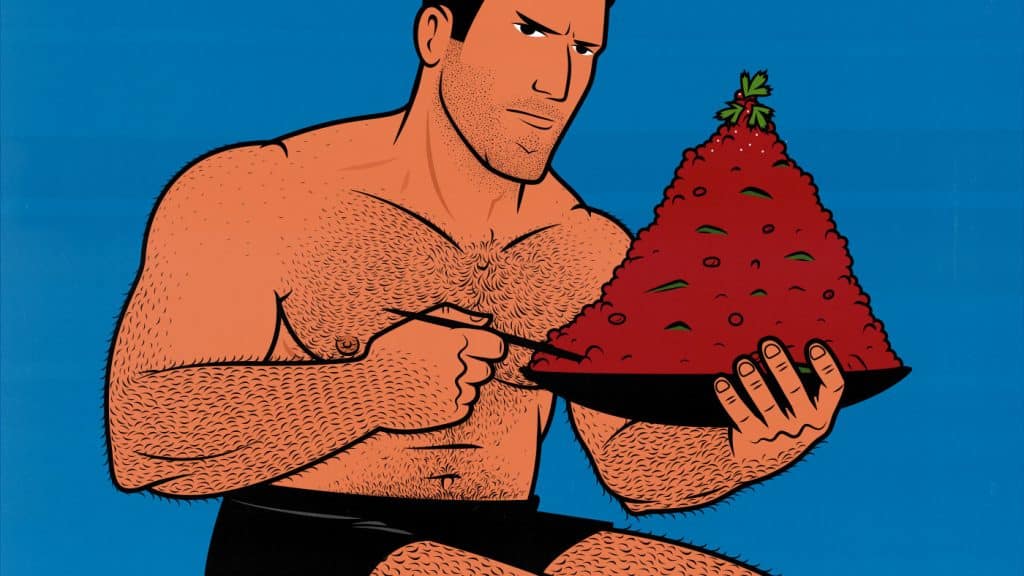
High-Calorie, High-Protein Vegan Bulking Meals (With Recipes)
We’ve already covered whether vegan diets are good for building muscle and explained how to bulk on a plant-based diet. Now, let’s arm you with some vegan bulking meals. All of these recipes are nutritious, high in calories, and high in protein.
You might worry you won’t get enough protein, but most plant-based foods have some protein, and with all these extra calories coming in, it adds up quickly. I think you’ll be surprised at how simple this can be.
If you make your diet out of these meals, they’ll give you 3,000 calories and nearly 200 grams of protein. That’s more than enough protein to maximize your rate of muscle growth.

How to Eat a Bulking Diet
The trick to eating a good bulking diet is to eat normal meals and make gradual changes. Your digestive system has gotten used to eating the foods you already eat, in the quantities you usually eat, at the times you normally eat them.
Bulking means adding more calories to your diet. That’s already hard, and it will only get harder if you surprise your digestive system with new schedules, new foods, and radically different serving sizes. Instead, make your meals a little bigger, add a snack, have a side of soy or oat milk, or have a protein shake after your workouts.
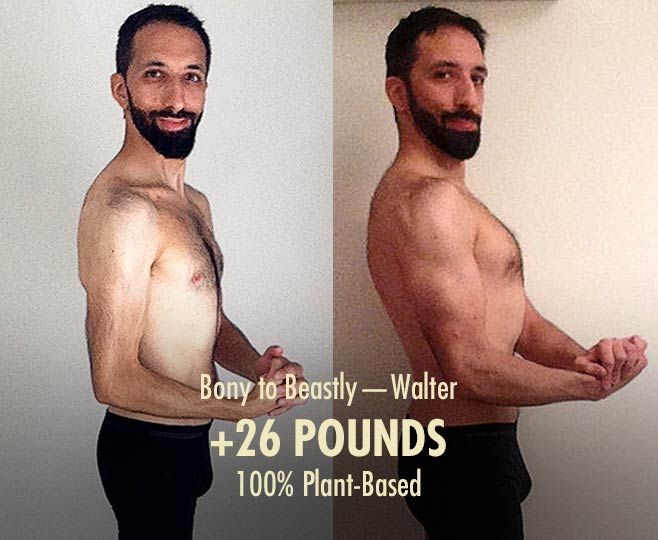
You only need an extra 250–500 calories to start your bulk. You’ll probably need to gradually add more calories every few weeks, but that’s usually enough to start gaining weight.
If you want to swap out your meals for these ones, I recommend doing it one meal at a time, giving yourself a couple of weeks to adjust before making more swaps.
The Recipes
Green Bulking Smoothie
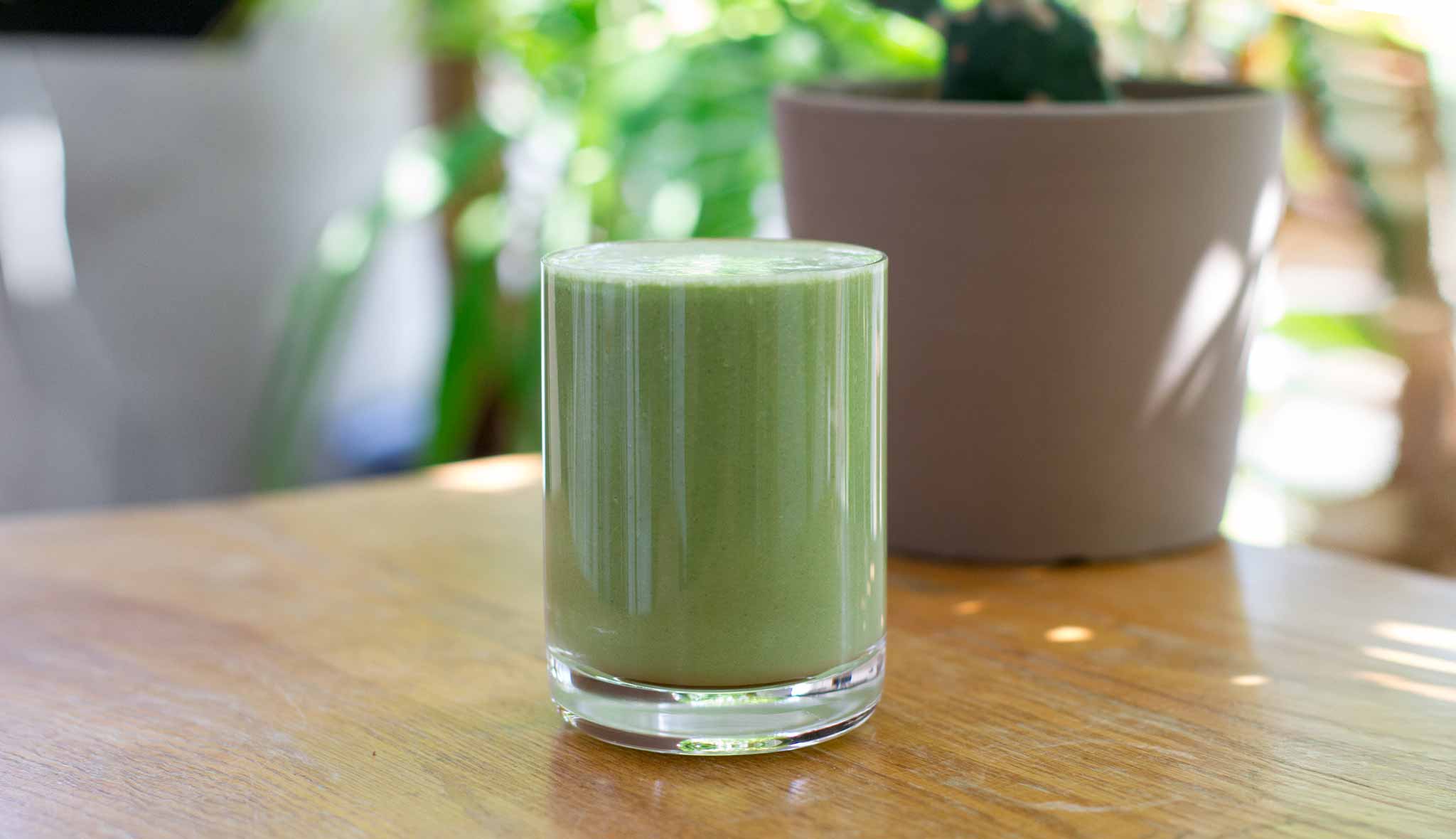
If you’re having trouble gaining weight, have a smoothie 1–2 hours before or after breakfast. Smoothies are the quickest and easiest way to boost your protein and calories. They take a couple of minutes to make, less than a minute to drink, and they pass through your digestive system quickly. They’re also packed full of nutritious ingredients, turning them into whole-food multivitamins.
The most common beginner mistake is to cram everything into one smoothie. You might be tempted to fill the blender with five handfuls of spinach, three scoops of protein powder, two cups of oats, and a slew of ingredients that don’t even belong in smoothies (like carrots and broccoli). Your stomach won’t like that. Keep the serving sizes normal. Don’t add more of an ingredient than you would eat in a normal meal.
This is a very basic smoothie. It tastes exactly like you’d imagine a green smoothie would taste. If you want more exotic recipes, we have a full article on high-calorie bulking smoothies.
Calories & Macros
- Calories: 500 kcal
- Protein: 40 grams
- Carbs: 55 grams
- Fat: 20 grams
- Fibre: 20 grams
Ingredients
- 1 banana (fresh or frozen)
- 1 handful fresh spinach
- 1 tablespoon of almond butter
- 4 frozen strawberries
- 1 tablespoon flax or chia seeds
- 225ml of cold soy or oat milk
- 1 scoop of protein powder*
*Cassandra and I use a pea and rice protein blend by Birdman. NOW’s pea protein is also great. More on the best protein brands here.
Instructions
- Blend all the ingredients except for the protein powder.
- Add the protein powder and blend gently until it’s mixed in.
Bodybuilder Oatmeal
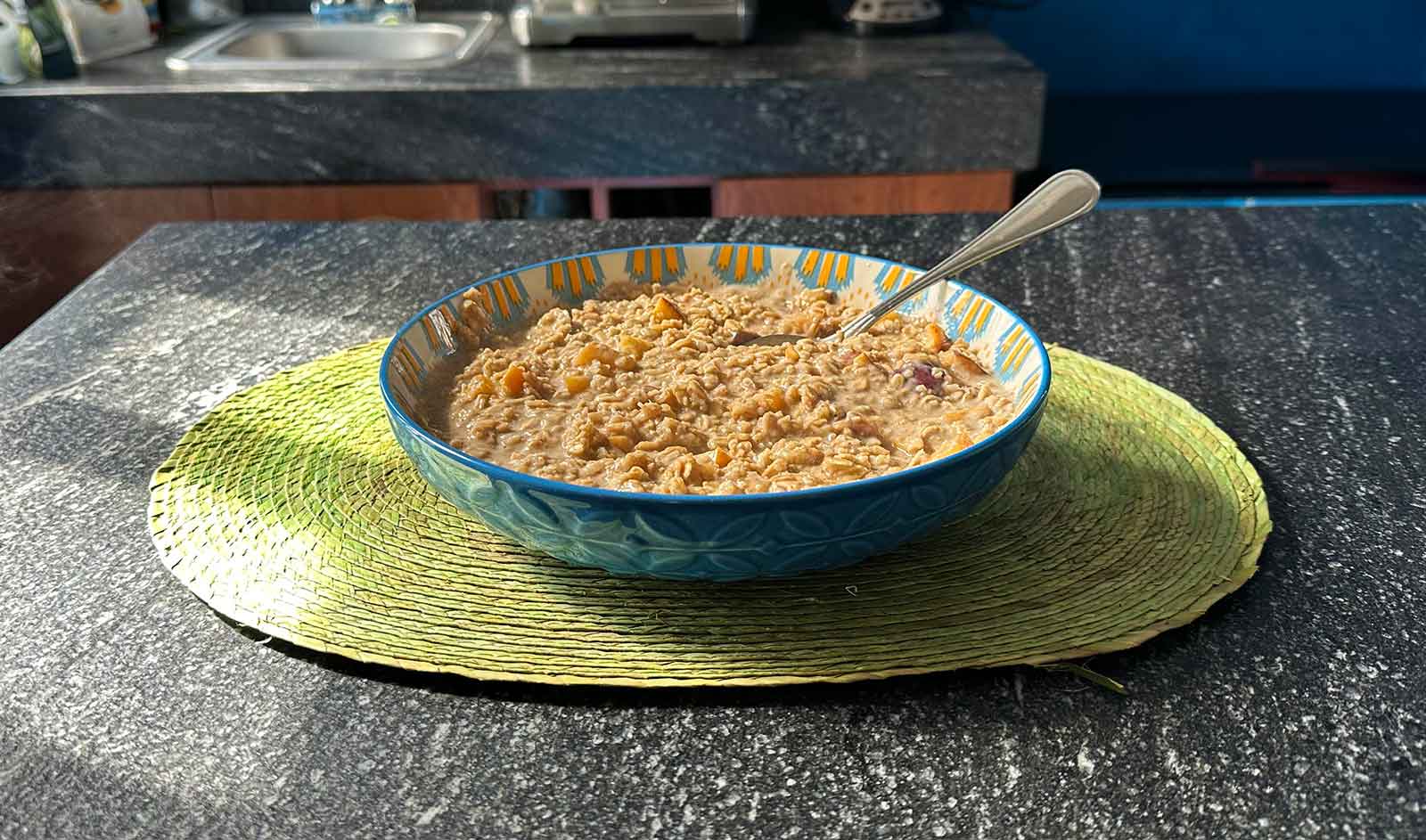
Oatmeal is the classic bodybuilding breakfast. It’s high in starchy carbs, rich in fibre, and packed full of nutrients—the ultimate “clean” breakfast, as the bodybuilders like to say.
However, oatmeal is notoriously filling. When I first started eating it, I had a hard time getting into a calorie surplus. I’m a naturally skinny guy with a fast metabolism, a small stomach, and a meagre appetite. Oatmeal wasn’t helping.
Here’s the secret: make your oatmeal with high-calorie liquids and powders. In this case, we’re using soy milk, maple syrup, and protein powder. They add tons of calories without meaningfully increasing the volume, allowing you to fit more calories into your stomach more easily.
The other problem is that oatmeal can be bland and mushy. Fruit can fix that. You can use berries, apples, or mangos, but my favourite is peaches. Peaches are juicy and tart, adding bursts of flavour and texture.
Calories & Macros
- Calories: 750 kcal
- Protein: 50 grams
- Carbs: 105 grams
- Fat: 15 grams
- Fiber: 10 grams
Ingredients
- 1 cup oats (such as quick oats)
- 2 cups soy milk
- 1 diced peach
- 1 tbsp agave or maple syrup
- 1 scoop protein powder
- A few dashes of cinnamon
- A pinch of iodized salt
- A few drops of vanilla (optional)
- 1 tsp ashwagandha powder (optional)
Ashwagandha tastes quite good mixed into oatmeal. It seems to improve mood and help with recovery (meta, meta). Mind you, the effect isn’t strong, and you don’t need to use it.
Instructions
- Add 2 cups of soy milk and 1 cup of oats to a pot and set it over low heat.
- Dice the peach and toss it in. Stir in the syrup, protein powder, cinnamon, and salt. You can add vanilla and ashwagandha if you want.
- Hopefully, it’s boiling by now. If you’re using quick oats, simmer for around 5 minutes. Old-fashioned oats will take a few minutes longer.
- The oatmeal should come out slightly watery. That’s good. The oats will soak up more water as they cool, and you don’t want your oatmeal overly dry.*
*Dry foods are calorically denser, so a common beginner mistake is to make everything dryer. However, it’s harder to chew and swallow dry foods, and you’ll need to drink fluid to digest them. It’s usually easier to have some moisture in your meals. Think of the chanko nabe sumo wrestlers bulk with. It’s a soupy stew.
Peanut Butter Sandwiches

Plant-based foods often have less protein per calorie, making it harder to eat enough protein. However, there’s a simple trick. Some vegan foods, like nuts and seeds, are a mix of fat and protein. Others, like whole grains, are a mix of carbs and protein. Neither has enough protein by itself, but when you mix them together, you get a fully balanced meal.
In this case, we’re mixing peanut butter (fat and protein) with whole-grain bread (carbs and protein). But that will taste dry and stick in your throat, especially if you’re using enough peanut butter to hit your calorie and protein targets. So, to make it more palatable, add bananas or jam. Maybe have it with a side of soy or oat milk.
It’s a simple recipe, I know. But it’s also a classic. High-school athletes have been bulking with peanut butter sandwiches for generations.
Calories & Macros
- Calories: 450 kcal
- Protein: 20 grams
- Carbs: 75 grams
- Fat: 17 grams
- Fiber: 12 grams
If you need more calories or protein, a cup of unsweetened soy milk will add around 100 calories and 8 grams of protein, depending on the brand. A cup of oat milk will give you around 120 calories and 3 grams of protein.
Ingredients
- 2 slices of whole-grain bread
- 2 tbsp peanut butter
- 1 banana (or jam)
Instructions
- Lightly toast the bread. Don’t make it too dry.
- Spread the peanut butter on a slice of bread. It may seem like too much, but it’s exactly the right amount.
- Slice the banana into exactly nine slices and artfully arrange those slices on the peanut butter.
- Close the sandwich.
Energy Balls
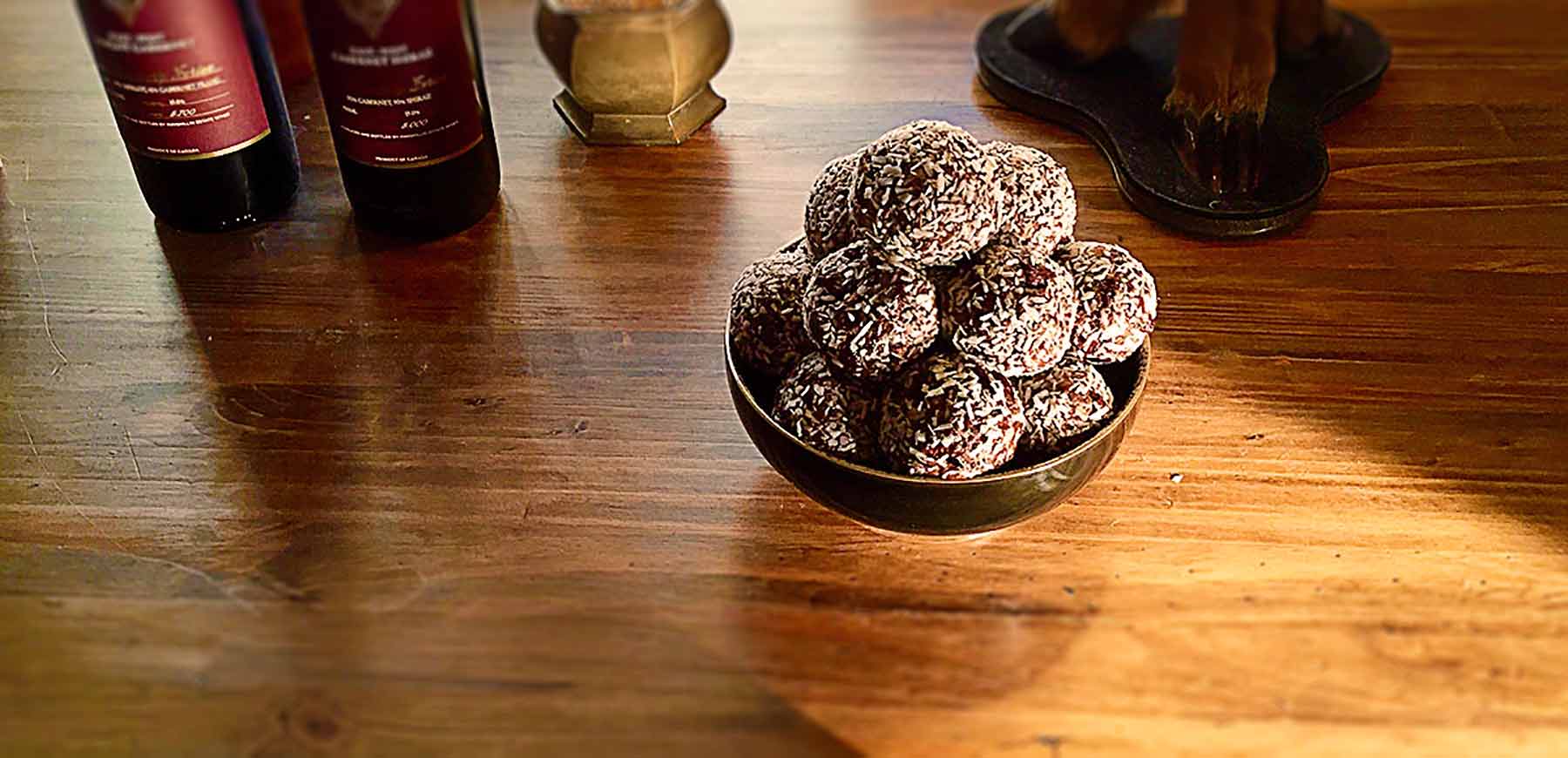
To gain weight, you need to get into a calorie surplus. Different people bulk at different speeds, but a good default is to add 250 calories for a lean bulk or 500 calories for a classic bulk. These energy balls are perfect for that. If your weight gain stalls, you’ll need to add even more calories, so add an extra energy ball.
Cassandra learned how to make these while studying nutrition. She calls them energy balls because cacao has natural stimulants in it. I call them energy balls because they’re incredibly high in calories. They’re also high enough in protein, they only take a few minutes to make, and you can make several servings at once.
The recipe makes 15 balls that keep in the fridge for a week.
Calories & Macros
- Calories: 250 kcal per ball
- Protein: 10 grams
- Carbs: 40 grams
- Fat: 12 grams
- Fibre: 5 grams
Each ball has 250 calories and 10+ grams of protein. So if you have 3 of them, that’s 750 calories and 30+ grams of protein.
Ingredients
- 1 cup quick or instant oats
- 1 cup peanut butter (or any nut butter)
- ⅔ cup maple or agave syrup
- ¼ cup cocoa powder
- 1½ scoops (45g) protein powder
- ¼ cup chia seeds
- 1½ cups dried fruit (like dried cherries)
- ½ cup coconut flakes
Instructions
- Spread the coconut flakes on a plate.
- Mix the rest of the ingredients in a bowl.
- Form the dough into 1.5-inch (4cm) balls, then roll them around in the coconut flakes. The coconut flakes add a nice texture and prevent the balls from being sticky. This should give you around 15 balls.
You can make endless variations of these. You can use chocolate chips instead of cocoa powder, roll the balls in matcha powder instead of coconut flakes, or use different types of nut butter.
Red Lentil Stew
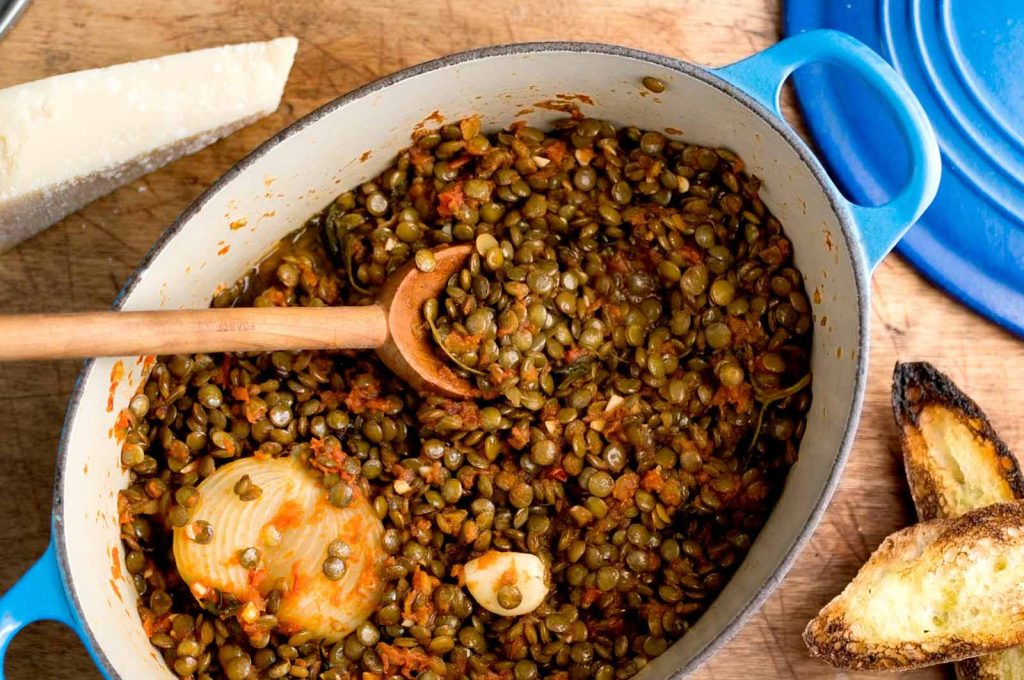
There’s a long tradition of using Sunday as meal-prep day. That’s when you’d buy your groceries, make your energy balls, and cook up a big pot of stew. That way, you start every week with a pantry and fridge stocked with healthy bulking meals, including both sweet and savoury options.
Lentils are high in protein, carbs, and fibre, so lentil stew is the obvious choice. It’s been one of my favourite bulking meals for almost a decade now. That’s my green lentil stew pictured above. This is a red lentil stew recipe I got from my friend Payam (which he got from Amy Chaplin’s At Home in the Whole Food Kitchen). It’s simpler, making for a better base to build upon.
If this becomes a staple meal in your diet, you’ll want some variation. You could add a red bell pepper and a chopped potato and spice it with cumin. Sometimes, we add a diced carrot or mix in frozen corn. Cassandra likes to add a bay leaf, though I can’t tell if it changes the flavour.
I like cooking these meals in bulk, so I’ll make twice as much and keep the leftovers in the fridge. Just make sure your pot is big enough.
Calories & Macros
- Calories: 650/serving (serves 4)
- Protein: 40 grams
- Carbs: 95 grams
- Fat: 12 grams
- Fibre: 12 grams
Ingredients
- 3 tbsp extra virgin olive oil
- 1 diced onion
- 6 minced garlic cloves
- 3 cups dry red lentils
- 9 cups water
- 6 cups baby spinach leaves
- ≈2 tsp iodized salt
- ≈½ tsp ground pepper
- 2 limes
Instructions
- Rinse and drain the lentils to wash off the dust and debris.
- Chop the onion and mince the garlic.
- Preheat the pot and add olive oil.
- When the oil is hot and shimmering, add the onions and sauté them for 5 minutes.
- Add the garlic and sauté for 2 more minutes.
- Add the lentils and water, turn the heat up, and bring the pot to a boil.
- Reduce the heat to low, cover the pot, and let the lentils simmer for 20–30 minutes. Stir the lentils every 10 minutes to make sure none of your calories get stuck to the bottom of the pot.
- Remove the lid, add more water if needed, and check to see if the lentils are cooked. I like them somewhat firm, but the classic recipe calls for them to be soft, so feel free to cook them for another 10 minutes.
- When the lentils are ready, stir in the pepper and spinach. Cook for another minute.
- Serve each bowl with half a lime (to squeeze in).
If you need more calories, you can add more olive oil. A teaspoon of olive oil adds 40 calories. A tablespoon adds 120. Lentil stew is low in fat, so it can handle the extra olive oil.
High-Protein Trail Mix

Trail mix has carried me through many a hard bulk. I’m eating that bag right now, snacking while typing. It’s a mix of dried cherries, almonds, pumpkin seeds, peanuts, and soybeans. The protein comes from pumpkin seeds, peanuts, and soybeans. The dried cherries make it taste much better.
This particular brand is popular here in Mexico, but I’ve found similar mixes in Canada and the United States. I think it’s fairly common. It’s no secret that pumpkin seeds, peanuts, and soybeans are high in protein.
This bag of trail mix is 150 grams, which is about a cup. It’s extremely high in calories.
Calories & Macros
- Calories: 700 kcal
- Protein: 40 grams
- Carbs: 18 grams
- Fat: 48 grams
- Fiber: 18 grams
Vegan Bulking Meal Plan
This is an example of a 3,000-calorie meal plan. For 4,000 calories, add the trail mix and another energy ball. If you aren’t sure how many calories to eat, we’ve got a bulking calorie calculator here.
- Breakfast: Bodybuilder Oatmeal
- Second Breakfast: Green Bulking Smoothie
- Lunch: Peanut Butter Sandwich + 1½ cups Soy Milk
- Second Lunch: 2 Energy Balls
- Dinner: Red Lentil Stew
Calories & Macros
- Calories: 3,000 kcal
- Protein: 182 grams
- Carbs: 415 grams (46%)
- Fat: 95 grams (30%)
- Fiber: 65 grams
To maximize your rate of muscle growth while bulking, you need around 0.7 grams of protein per pound of body weight per day (full explanation). That means 182 grams of protein is enough for anyone who weighs less than 260 pounds.
The protein comes from whole grains, legumes, nuts, seeds, soy, and protein powder, giving you all the amino acids you need. The carbs and fats are perfectly optimized, but they don’t need to be. You can adjust your carb and fat macros to suit your preferences. These meals are all low in saturated fat and high in fibre.
You’re welcome to use the meal plan as is, but I highly recommend customizing it. Keep eating the meals you already like. Add your favourite recipes. Feel free to switch the ingredients.
You may want to supplement this diet with creatine, vitamin B12, DHA from algae, and a few other vitamins and minerals. We’ve written more on that here.
Should You Track Calories?
If you want to track your calories, you could use a calorie-tracking app like MacroFactor—more on that here. It can be a great learning experience, especially if you’re still trying to figure out what a balanced diet looks like.
But you don’t need to track your calories. You can get into a steady rhythm of eating similarly sized meals at similar times every day. If you’re currently maintaining your weight, you can get into a calorie surplus by adding 250–500 calories to your diet (1–2 energy balls). Then, whenever your weight gain stalls for more than two weeks, add another 200 calories (+1 energy ball).
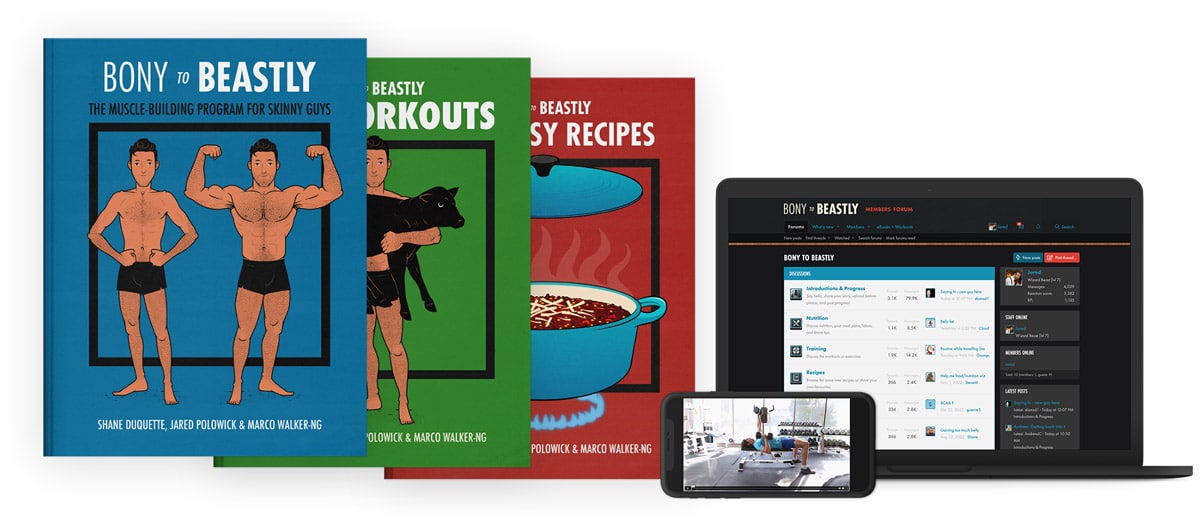
If you want us to walk you through the entire bulking process, check out our Bony to Beastly (men’s) program or Bony to Bombshell (women’s) program. They include a 5-month customizable workout routine, a full bulking diet plan, a bulking recipe book, a deep dive into lifestyle and fitness, and personal coaching from us in our online community.

